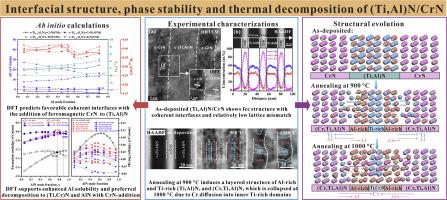Influence of magnetism on the interfacial structure, phase stability and thermal decomposition of (Ti,Al)N/CrN multilayers: Ab initio and experimental study
IF 8.3
1区 材料科学
Q1 MATERIALS SCIENCE, MULTIDISCIPLINARY
引用次数: 0
Abstract
By virtue of its outstanding structural and thermal stability, the (Ti,Al)N/CrN multilayer has attracted widespread attention over recent decades. However, the temperature-sensitive magnetic arrangement within the CrN layer challenges the research on the intrinsic mechanism of performance enhancement, where a paramagnetic-to-antiferromagnetic transformation occurs below Néel temperature of 280 K. Here, we systematically studied the effect of magnetic ordering on interfacial and phase stability as well as the thermal decomposition behavior of (Ti,Al)N/CrN multilayer combining experimental and theoretical approaches. The synthesized (Ti,Al)N/CrN multilayer exhibits a face-centered cubic structure with well-defined coherent interfaces. Ab initio calculations confirm that the coherent epitaxial growth between (Ti,Al)N and TMN (TM = Ti, Zr, and Cr) depends on the layer-to-layer lattice mismatch and the Al content within the (Ti,Al)N layer. Compared to antiferromagnetic feature, the ferromagnetic one in CrN enhances the coherent interface stability and interface bond strength, but has little influence of the cubic phase stability. Moreover, annealing treatment promotes the interface-directed spinodal decomposition of (Ti,Al)N/CrN due to ferromagnetic configuration, which reduces the activation energy of Al nearby interfaces along the preferred diffusion towards the interior of the (Ti,Al)N layers. Thereby, the (Ti,Al)N layer forms lamellar Al-rich/Ti-rich/Al-rich regions. As temperature increases to 1000 °C, Cr crosses the fcc-AlN-rich lamella towards the inner fcc-TiN-rich lamella of the original (Ti,Al)N layer, which brings about the collapse of the lamellar structure.


求助全文
约1分钟内获得全文
求助全文
来源期刊

Acta Materialia
工程技术-材料科学:综合
CiteScore
16.10
自引率
8.50%
发文量
801
审稿时长
53 days
期刊介绍:
Acta Materialia serves as a platform for publishing full-length, original papers and commissioned overviews that contribute to a profound understanding of the correlation between the processing, structure, and properties of inorganic materials. The journal seeks papers with high impact potential or those that significantly propel the field forward. The scope includes the atomic and molecular arrangements, chemical and electronic structures, and microstructure of materials, focusing on their mechanical or functional behavior across all length scales, including nanostructures.
 求助内容:
求助内容: 应助结果提醒方式:
应助结果提醒方式:


